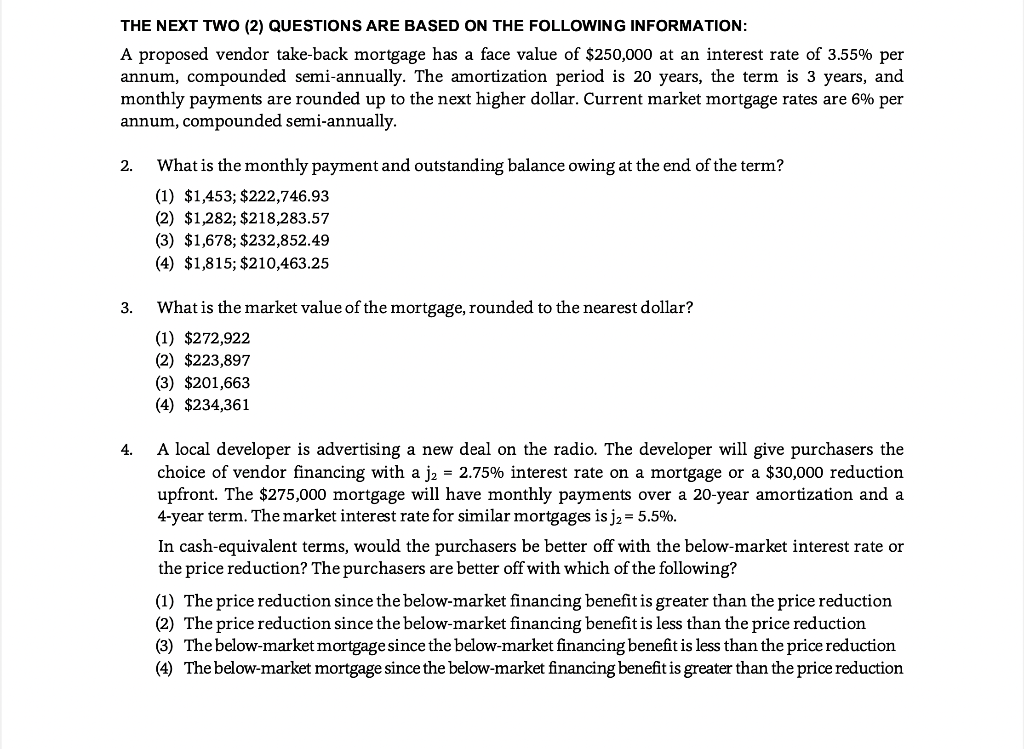
THE NEXT TWO (2) QUESTIONS ARE BASED ON THE FOLLOWING INFORMATION: A proposed vendor take-back mortgage has a face value of $250,000 at an interest rate of 3.55% per annum, compounded semi-annually. The amortization period is 20 years, the term is 3 years, and monthly payments are rounded up to the next higher dollar. Current market mortgage rates are 6% per annum, compounded semi-annually. 2. What is the monthly payment and outstanding balance owing at the end of the term? (1) $1,453; $222,746.93 (2) $1,282; $218,283.57 (3) $1,678; $232,852.49 (4) $1,815; $210,463.25 3. What is the market value of the mortgage, rounded to the nearest dollar? (1) $272,922 (2) $223,897 (3) $201,663 (4) $234,361 4. A local developer is advertising a new deal on the radio. The developer will give purchasers the choice of vendor financing with a j2 = 2.75% interest rate on a mortgage or a $30,000 reduction upfront. The $275,000 mortgage will have monthly payments over a 20-year amortization and a 4-year term. The market interest rate for similar mortgages is j2 = 5.5%. In cash-equivalent terms, would the purchasers be better off with the below- market interest rate or the price reduction? The purchasers are better off with which of the following? (1) The price reduction since the below-market financing benefit is greater than the price reduction (2) The price reduction since the below-market financing benefit is less than the price reduction (3) The below-market mortgage since the below- market financing benefit is less than the price reduction (4) The below-market mortgage since the below-market financing benefit is greater than the price reduction THE NEXT TWO (2) QUESTIONS ARE BASED ON THE FOLLOWING INFORMATION: A proposed vendor take-back mortgage has a face value of $250,000 at an interest rate of 3.55% per annum, compounded semi-annually. The amortization period is 20 years, the term is 3 years, and monthly payments are rounded up to the next higher dollar. Current market mortgage rates are 6% per annum, compounded semi-annually. 2. What is the monthly payment and outstanding balance owing at the end of the term? (1) $1,453; $222,746.93 (2) $1,282; $218,283.57 (3) $1,678; $232,852.49 (4) $1,815; $210,463.25 3. What is the market value of the mortgage, rounded to the nearest dollar? (1) $272,922 (2) $223,897 (3) $201,663 (4) $234,361 4. A local developer is advertising a new deal on the radio. The developer will give purchasers the choice of vendor financing with a j2 = 2.75% interest rate on a mortgage or a $30,000 reduction upfront. The $275,000 mortgage will have monthly payments over a 20-year amortization and a 4-year term. The market interest rate for similar mortgages is j2 = 5.5%. In cash-equivalent terms, would the purchasers be better off with the below- market interest rate or the price reduction? The purchasers are better off with which of the following? (1) The price reduction since the below-market financing benefit is greater than the price reduction (2) The price reduction since the below-market financing benefit is less than the price reduction (3) The below-market mortgage since the below- market financing benefit is less than the price reduction (4) The below-market mortgage since the below-market financing benefit is greater than the price reduction







